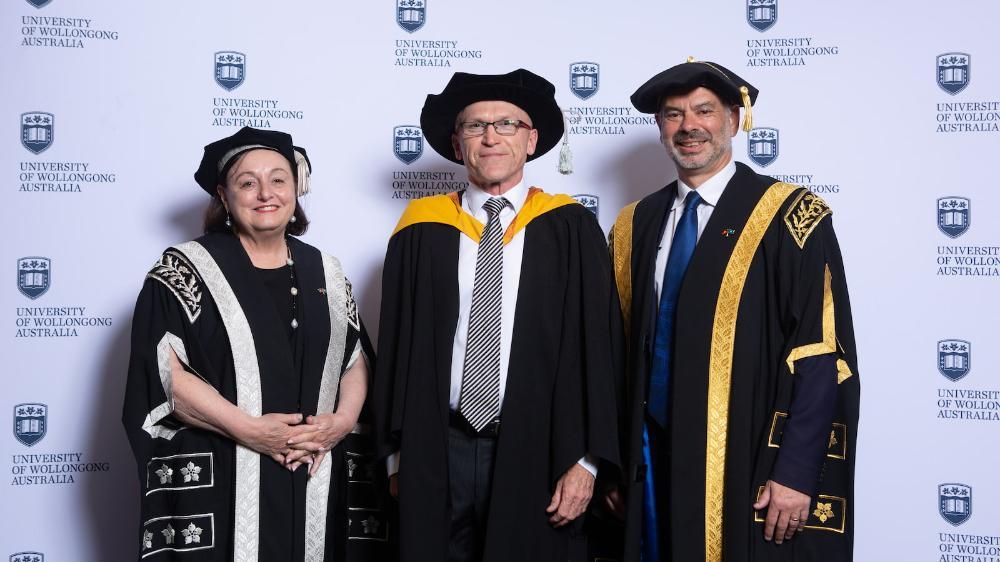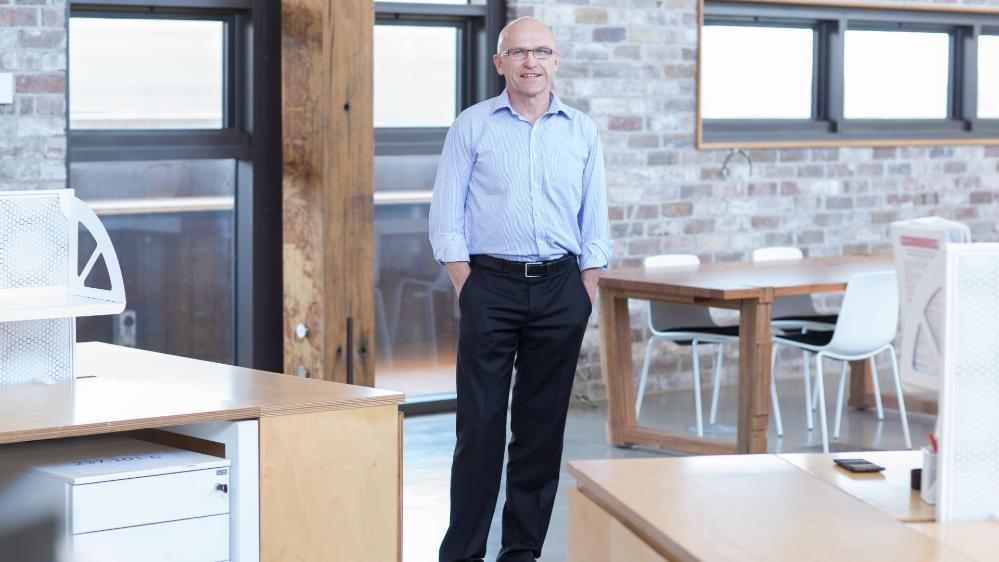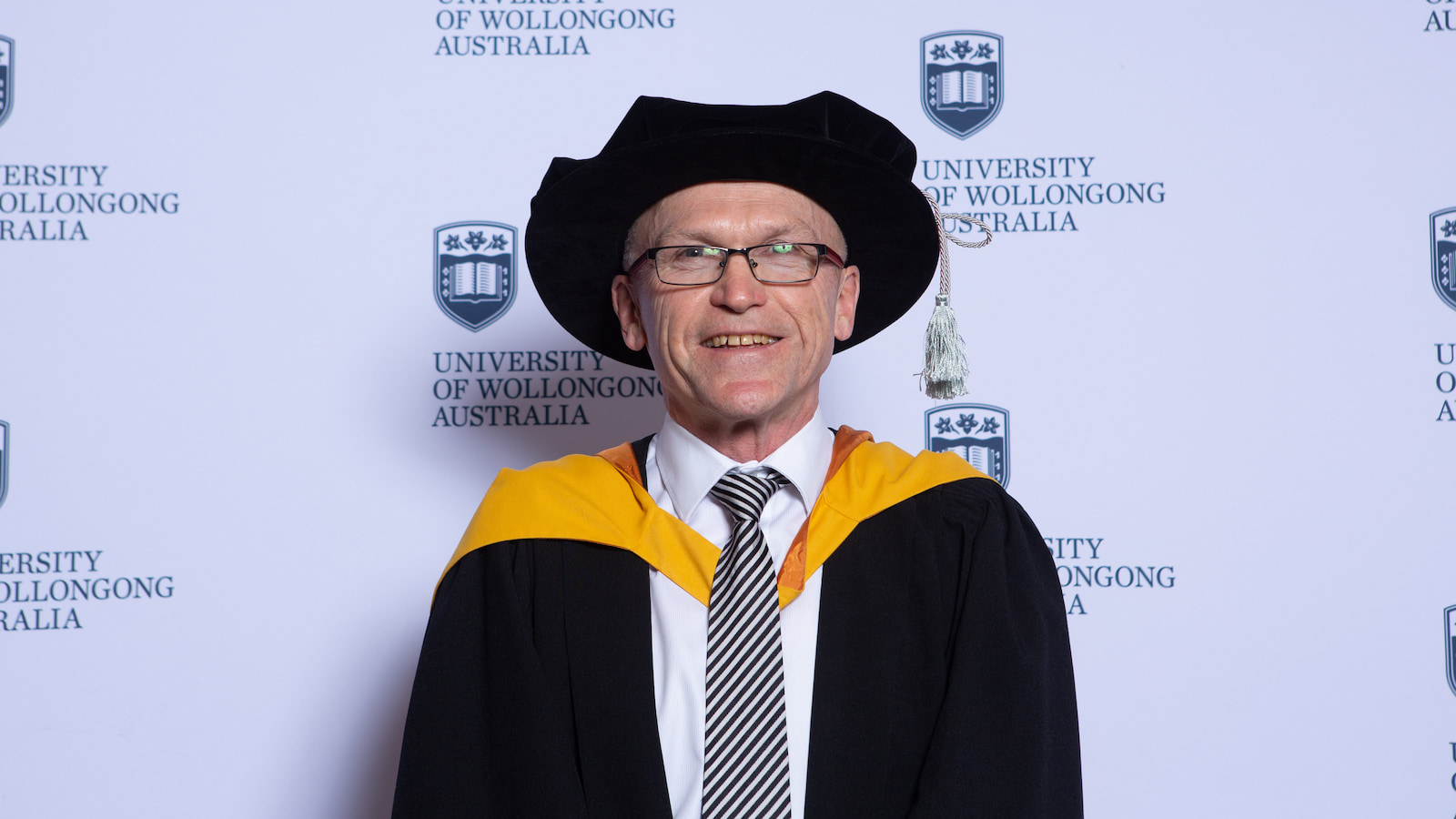November 1, 2023
Sustainable building expert receives Emeritus Professor honour
Professor Paul Cooper reflects on long career at the helm of the groundbreaking Sustainable Buildings Research Centre
A visit to the Centre for Alternative Technology in Wales in the early 1980s lit a spark in Professor Paul Cooper.
More than 40 years later, Professor Cooper is recognised as one of the world’s pre-eminent researchers into sustainable buildings and can now add Emeritus Professor to his long list of accomplishments.
He received the honour during the Faculty of Engineering and Information Sciences graduation ceremony at the University of Wollongong (UOW) yesterday (Wednesday 31 October).
In 1976, after graduating with a Bachelor of Science in Electrical Engineering from Imperial College in London, he began to question whether he was on the right career path.
“Once I’d done my first degree in electrical engineering, I wasn’t entirely sure where I was heading,” he said.
“I knew I didn’t want to go into traditional electrical engineering and was more interested in how engineering could be used to make our society environmentally sustainable.”
Professor Cooper went back to study further at Imperial College, completing his Masters of Science, in Social and Psychological Aspects of Science and Technology and then his PhD in 1986 on Electro-hydrodynamic Heat Transfer Enhancement.
Along the way, and almost by accident, he stumbled upon the Centre for Alternative Technology, which is a not-for-profit demonstration of sustainable buildings and renewable energy systems.
“There wasn’t really anywhere quite like that elsewhere in the world,” he says.
Its impact was profound, and it wasn’t long before Professor Cooper, then in his late 20s, won a position with the Built Environment Research Group at the Polytechnic of Central London (now the University of Westminster), which was a leading team researching UK sustainable energy in buildings at the time.
“We were a small group of five researchers, and amongst other things we built the largest group solar heating system of the time in the UK as part of a new-build council estate in North London,” he said.
“Our research group was situated within the School of Architecture, although the staff there were focussed more on the form and aesthetics of buildings than engineering issues such as thermal comfort and energy performance.”

Vice-Chancellor Professor Patricia M Davidson, Professor Paul Cooper, and Deputy Chancellor Warwick Shanks.
It was the start of what would become his passion and he conducted research on energy efficiency, condensation and mould in buildings, renewable energy, and numerical simulation of building performance.
“The research group in London was one of the first groups that was part of a new community of researchers who were modelling how buildings perform in terms of thermal comfort and energy consumption,” he said.
“That was nearly 40 years ago, and since that time simulation tools have been steadily evolving to analyse many complex aspects of building physics.”
Climate change and sustainability weren’t at the front of the people’s mind back then, Professor Cooper said, but there were still echoes of concern in the community about what might happen with increasing fossil fuel consumption for those, like him, who had lived through the fuel crisis of the early ‘70s.
“There were strong concerns from sections of the scientific world for the environment and the use, or overuse, of energy,” he said.
“And the poor sustainability performance of buildings was no surprise given the lack of energy efficiency regulations. Only a small proportion of the population then were interested in the energy efficiency of buildings.”
While working with that group of researchers, Professor Cooper began to look further afield for opportunities to work in the emerging field of sustainability.
“I almost went to Sri Lanka as an alternative technology officer with Voluntary Services Overseas but decided I needed to come to Australia first,” he said.
In 1988 he migrated to Australia after being appointed as a lecturer at UOW in the then Department of Mechanical Engineering.
Subsequently, in 2008, he became the Head of the School of Mechanical, Materials and Mechatronic Engineering at UOW.
It was in 2010 that Professor Cooper’s vision of what could be achieved through sustainable building research really began to come to fruition.
He was a key member of team that was successful in winning a $25 million government grant for the University to build a major Sustainable Buildings Research Centre (SBRC).
“There wasn’t a great deal of opportunity or resources to support research in this area previously, so when the chance came around to apply for funding in 2010 and the University was successful, it was absolutely a dream come true for me,” Professor Cooper said.
“I think this came about because of the rapidly growing awareness of the impacts of human-induced climate change and that greenhouse gas emissions from the construction and operation of buildings contribute significantly – this is one of the biggest drivers out of research.”
Professor Cooper says the $25 million grant to create the SBRC represented a unique opportunity to bring together top architects and engineers to design a world-class building that was ahead of its time.
“When the University appointed me as Director of the centre it was not only a great honour, but also a huge responsibility to make the best of that opportunity,” he said.
“And from the start, we set out to create a building for the SBRC that would set a new sustainability benchmark for years to come. I believe we succeeded since the SBRC Building is the only building in Australia, and only the third outside of the US, to have won full Living Building accreditation.
“It certainly was a dream come true for me to have had the privilege of leading the development of our SBRC.
“It was a dream that started with my visit to the Centre for Alternative Technology in Wales all those years ago.”

Professor Paul Cooper at the Sustainable Buildings Research Centre.
Professor Cooper says winning the grant and constructing the building was only the start of the project.
A key part of his new position as Director was to recruit the best and brightest minds in both researchers and students but it was going to be a big task to persuade them to take a chance and come to work in the fledgling enterprise.
“It was incredibly exciting. We were really starting from scratch. There wasn’t any sustainable buildings research activity in the university up until that point, so we had to build an entirely new research team around the project and attract high-quality research students,” he said.
To raise the profile of the SBRC, Professor Cooper decided UOW should try to win entry into the global Solar Decathlon competition, which was, and still is, the largest student-led program of competitions in the world.
The competition involved student teams from around the world designing and building a net zero energy, sustainable, attractive, and affordable house, which they then had to transport to the competition site and assemble and fit it out in just 10 days.
In early 2011, with the support of the then Vice-Chancellor Professor Paul Wellings and senior university colleagues, Team UOW became the first Australian team to win entry to a Solar Decathlon.
In fact, the entry was accepted for both the US competition and the first Solar Decathlon China competition held in Datong, 400km west of Beijing.
“Entering the Solar Decathlon was a massive commitment because setting up the Sustainable Buildings Research Centre was itself a huge challenge, so to then, in parallel, set about trying to win the biggest competition that university students can be involved in was a massive two-and-a-half-year effort,” he says.
Team UOW’s entry was the first-ever proposal from any of the previous, approximately 160, Solar Decathlon teams from around the globe, to demonstrate how to upgrade an existing building rather than develop a new building design from scratch.
“The University supported us, and over 80 students were involved together with my academic staff colleagues who put in a huge effort as well,” he said.
“The team won the competition with the highest number of points ever up to that point in time – and that record stood for many years.
“I was personally both elated and relieved because I felt such a great responsibility over those two years for us to succeed.
“We demonstrated through the Solar Decathlon success that we were up there with some of the best universities in the world when it came to sustainability and sustainable buildings.
“I believe the win by Team UOW did a lot for the international reputation of the University and helped to attract top students to study here - and it certainly helped to galvanise support for sustainable buildings in the community and industry.
“Importantly, it also provided the foundation for our reputation of the SBRC being a centre of excellence in the research of sustainable buildings.”
Amongst many other research interests, Professor Cooper has also worked on research into making Australian homes more resilient to the impacts of climate change.
“The SBRC team are generating new knowledge and evidence on how to make buildings not only more sustainable but also more resilient to disasters, particularly those that will get more frequent and intense due to the impacts of global heating and climate change,” he said.
Over the past decade he and his colleagues have particularly focussed on the retrofitting of existing homes to increase resistance to bushfires, and on the performance of bushfire water sprinkler systems. He is also involved in efforts to improve bushfire and disaster resilience within his own local community.
In 2019, Professor Cooper was awarded the James Harrison Medal of the Australian Institute for Refrigeration Air Conditioning and Heating (AIRAH), the highest honour bestowed by AIRAH on an individual. Only five such awards were made in the previous 10 years.
Professor Cooper sees his latest accolade of an Emeritus Professorship as another way for the SBRC to continue to be at the centre of global research into sustainable buildings.
“Receiving the Emeritus Professorship means an enormous amount to me. It is recognition of not just what I have done, but also what the SBRC research team has achieved,” he said.
“It also allows me to continue to work with my colleagues at the centre and bolsters our opportunities to put in grant applications for funding that I can participate in as an Emeritus Professor, and further grow our activities and impact.
“It was always a dream to be part of a centre like this.
“I have a colleague from those days who came out for the first international conference we put on at the SBRC as a keynote speaker. Like me, he was a director of a major research centre at the University College, London.
“My other former colleagues are on a similar path and although we were in a very small group at the Polytechnic of Central, we have all had some influence on sustainability and buildings.
“It’s been a real privilege to have these opportunities along the way.”
